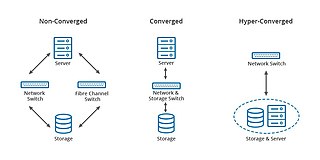Related Research Articles
Customer relationship management (CRM) is a process in which a business or other organization administers its interactions with customers, typically using data analysis to study large amounts of information.
Marketing management is the strategic organizational discipline which focuses on the practical application of marketing orientation, techniques and methods inside enterprises and organizations and on the management of a firm's marketing resources and activities.
HP OpenView is the former name for a Hewlett-Packard product family that consisted of network and systems management products. In 2007, HP OpenView was rebranded as HP BTO Software when it became part of the HP Software Division. The products were available as various HP products, marketed through the HP Software Division. HP Software became part of HPE after the HP/HPE split and HPE Software was eventually sold to MicroFocus.

A performance indicator or key performance indicator (KPI) is a type of performance measurement. KPIs evaluate the success of an organization or of a particular activity in which it engages. KPIs provide a focus for strategic and operational improvement, create an analytical basis for decision making and help focus attention on what matters most.
Field service management (FSM) refers to the management of a company's resources employed at or en route to the property of clients, rather than on company property. Examples include locating vehicles, managing worker activity, scheduling and dispatching work, ensuring driver safety, and integrating the management of such activities with inventory, billing, accounting, and other back-office systems. FSM most commonly refers to companies that need to manage installation, service, or repairs of systems or equipment. It can also refer to software and cloud-based platforms that aid in field service management.
Cincom Systems, Inc., is a privately held multinational computer technology corporation founded in 1968 by Tom Nies, Tom Richley, and Claude Bogardus.
Project workforce management is the practice of combining the coordination of all logistic elements of a project through a single software application. This includes planning and tracking of schedules and mileposts, cost and revenue, resource allocation, as well as overall management of these project elements. Efficiency is improved by eliminating manual processes, like spreadsheet tracking to monitor project progress. It also allows for at-a-glance status updates and ideally integrates with existing legacy applications in order to unify ongoing projects, enterprise resource planning (ERP) and broader organizational goals. There are a lot of logistic elements in a project. Different team members are responsible for managing each element and often, the organisation may have a mechanism to manage some logistic areas as well.
Customer attrition, also known as customer churn, customer turnover, or customer defection, is the loss of clients or customers.
Revenue management is a discipline to maximize profit by optimizing rate (ADR) and occupancy (Occ). In its day to day application the maximization of RevPAR is paramount.
Analytic applications are a type of business application software, used to measure and improve the performance of business operations. More specifically, analytic applications are a type of business intelligence. As such they use collections of historical data about business operations to provide business users with information and tools that allow them to make improvements in business functions.

NetSuite Inc. is an American cloud-based enterprise software company that provides products and services tailored for small and medium-sized businesses (SMBs) including accounting and financial management, customer relationship management, inventory management, human capital management, payroll, procurement, project management and e-commerce software. NetSuite was founded in 1998 with headquarters in Austin, Texas. The company is widely seen as the first cloud computing software company, with its founding pre-dating that of Salesforce by about a month.
Practice management is the term used in General practice for the person who manages the finance and administration of a doctor's office or an office of a medical professional in one of many types of specialties in medicine. This is distinct from other official titles such as Advanced Practice Manager, which are generally clinical. A practice manager is responsible for the administrative responsibilities of daily operations and development of a business strategy. Most practice managers are responsible for hiring staff, negotiating benefits and personnel policies, ensuring that medical supplies are ordered and equipment is maintained, ensuring regulatory compliance, and the development and marketing of service lines. Practice management encompasses multiple topics including governance, the financial aspects of medical billing, staff management, ancillary service development, information technology, transcription utilization, and marketing. Practice managers handle the business aspects of medicine to maximize provider time and enhance patient care.

Converged infrastructure is a way of structuring an information technology (IT) system which groups multiple components into a single optimized computing package. Components of a converged infrastructure may include servers, data storage devices, networking equipment and software for IT infrastructure management, automation and orchestration.
Law Practice Optimization, or Legal Practice Optimization, or simply LPO as it is also known, represents the practice carried out by Law Practice Optimizers of improving the efficiency and client/attorney relationships within a law firm and improves the client intake of the firm.

Projector PSA, Inc. is a developer of cloud-based professional services automation (PSA) software. On July 12, 2022, the company was acquired by BigTime Software.
The Digital Firm is a kind of organization that has enabled core business relationships through digital networks In these digital networks are supported by enterprise class technology platforms that have been leveraged within an organization to support critical business functions and services. Some examples of these technology platforms are Customer Relationship Management (CRM), Supply Chain Management (SCM), Enterprise Resource Planning (ERP), Knowledge Management System (KMS), Enterprise Content Management (ECM), and Warehouse Management System (WMS) among others. The purpose of these technology platforms is to digitally enable seamless integration and information exchange within the organization to employees and outside the organization to customers, suppliers, and other business partners.
In a business context, operational efficiency is a measurement of resource allocation and can be defined as the ratio between an output gained from the business and an input to run a business operation. When improving operational efficiency, the output to input ratio improves.

Act-On Software is a software-as-a-service product for marketing automation. The company is headquartered in Portland, Oregon and was founded in 2008, originally retailing its software exclusively through Cisco, which provided $2 million in funding.
Digital banking is part of the broader context for the move to online banking, where banking services are delivered over the internet. The shift from traditional to digital banking has been gradual, remains ongoing, and is constituted by differing degrees of banking service digitization. Digital banking involves high levels of process automation and web-based services and may include APIs enabling cross-institutional service composition to deliver banking products and provide transactions. It provides the ability for users to access financial data through desktop, mobile and ATM services.
Intelligent automation (IA), or alternately intelligent process automation, is a software term that refers to a combination of artificial intelligence (AI) and robotic process automation (RPA). Companies use intelligent automation to cut costs and streamline tasks by using artificial-intelligence-powered robotic software to mitigate repetitive tasks. As it accumulates data, the system learns in an effort to improve its efficiency. Intelligent automation applications consist of but are not limited to, pattern analysis, data assembly, and classification. The term is similar to hyperautomation, a concept identified by research group Gartner as being one of the top technology trends of 2020.
References
- ↑ "2007 PSVillage Professional Services Automation (PSA) End-User Survey" (PDF). SPI Research. Retrieved November 4, 2009.
- ↑ Rudolf Melik (April 2002). "PSA: Professional Services Automation: Optimizing Project and Service Oriented Organizations". Wiley; New York, NY.
{{cite journal}}: Cite journal requires|journal=(help) - ↑ R. David Hofferberth (April 2, 2001). "Professional Services Automation - Pointing the Way To Higher Profitability". ChannelWeb. Retrieved November 4, 2009.
- ↑ R. David Hofferberth (September 2017). "2017 PSA End-user Survey". Service Performance Insight. Retrieved October 31, 2017.